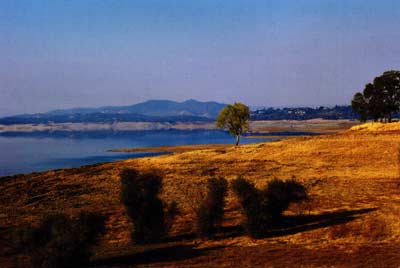
Unless you live in a cave far from civilization and modern means of communication, you have heard or read about global climate change or what was initially called global warming. The response to this issue has been varied: to ignore the matter entirely, consider it another hoax, try to change one's lifestyle to lessen one's contribution to it, trust science and the government to solve it, worry about its present or future effects; or some combination of these. Some pond owners may have even wondered if climate change will affect their fishpond.
I believe that the climate change issue has elicited so much concern from one extreme side and so much denial by the other extreme side that most who are in the middle are confused or have a distorted concept of the matter. Therefore, I want to say a few things about climate change and mention the effects that it might have on your fishpond.
A greenhouse is covered with glass or clear plastic. The sun's shortwave radiation enters the greenhouse readily through the glass or plastic cover. Objects inside the greenhouse absorb solar radiation, then re-radiate their warmth as longwave radiation. The loss of the longwave radiation emitted by the objects in the greenhouse back into the atmosphere is retarded by the glass or plastic cover, which interferes with the passing of longwave radiation. A portion of the heat in the greenhouse is retained. The same effect occurs if a car is parked in the sun with its windows closed on a cold day. If you return to the car after an hour or so, it will be very warm, even maybe hot, in your car.
The atmosphere provides a greenhouse effect on the Earth. The atmosphere contains some gases that do not impede shortwave solar radiation from striking the Earth. Nevertheless, these same gases act to retard in the atmosphere a portion of the longwave radiation that the Earth re-radiates back to space. Several natural gases, water vapor, carbon dioxide, methane, and nitrous oxide, are called greenhouse gases because they act to retard the escape of longwave radiation back to space. This is the natural greenhouse effect of the Earth's atmosphere, and carbon dioxide is the major natural greenhouse gas because the average resident time of this gas in the atmosphere is hundreds of years. Earth, without the natural greenhouse effect, would have an average global air temperature at its surface near or below the freezing point of water.
The Industrial Revolution began at the time of the invention of steam power, which was then generated mainly by burning the fossil fuel coal or the renewable fuel, wood. The usual date given for the beginning of the Industrial Revolution is 1760-1830. Since then, coal and other fossil fuels have significantly increased. At the beginning of the Industrial Revolution, the atmosphere contained approximately 275 parts per million of carbon dioxide. Before this, the carbon dioxide budget of the Earth was roughly balanced with the amount fixed in organic matter by the photosynthesis of green plants, which equaled, on an annual basis, the amount of this gas released by the respiration of all living things.
Once the industrial revolution began, coal, petroleum, and natural gas formed from sequestered organic matter from ancient times in the Earth's crust were mined or extracted by drilling and burned for energy with the release of carbon dioxide into the atmosphere. Moreover, the world population has increased drastically with science, industry, and healthcare advances. This has resulted in much deforestation and less natural carbon dioxide removal from the air.
An imbalance in the global carbon dioxide budget has resulted, and carbon dioxide concentration began to increase in the atmosphere. Today, the atmosphere contains over 400 parts per million of carbon dioxide, and the concentration is currently increasing at about three parts per million per year. The average global temperature is estimated to have risen about 1.1 degrees centigrade (1.98 degrees Fahrenheit) since 1830.
It is difficult to measure the average global temperature precisely, but it is certain that the carbon dioxide concentration, which has been measured daily for more than 50 years at the Mauna Loa Observatory in Hawaii, is increasing along with concentrations of the other natural and anthropogenic greenhouse gases. The measuring site in Hawaii was chosen because it is at a high elevation on an island in the middle of the Pacific Ocean, where the atmospheric gas concentrations should be relatively undisturbed by local emissions. The increase in greenhouse gases is beyond denial - it is happening. It is not some hoax perpetrated by the liberals. But that does not mean its effects on climate change cannot be exaggerated.
The results of the increased greenhouse effect are the melting of polar and glacial ice, sea level rise, ocean acidification because of increased carbon dioxide concentration, and greater frequency of extreme weather events. There is solid scientific evidence that these events are happening, but the predictions of the future climatic effects are all over the place as the expression goes. The quandary is that the future is challenging to predict with any degree of accuracy, and unforeseen events often overshadow and negate the validity of human predictions. The climate has changed throughout the past, but nature has continued to function with different climatic realities.
The concern is that humans, though different from the other living creatures, are part of and live in nature. Unfortunately, anthropogenic intrusions into natural cycles and other aspects of nature cause change, and such change seldom improves the status quo. Therefore, we must be concerned about climate change, but the Earth, nature, and mankind will continue until the time foreordained by the Creator. Humans influence the Earth and nature, but we do not control it. The universe has a destiny, and mankind will not change it. Nevertheless, mankind is responsible for conserving and protecting the environment and resources for future generations. Pollution is just a further bit of evidence of the imperfection of our race.
The question that remains: how will climate change affect my fishpond? One point is clear: more carbon dioxide in the atmosphere leads to more carbon dioxide in the water. Of course, greater temperature decreases the solubility of gases in water. Still, the rise in carbon dioxide concentration in the air is a much more significant factor affecting its solubility in water. The equilibrium concentration of carbon dioxide in freshwater at 25°C has increased from 0.42 parts per million in the 1960s to 0.58 parts per million today. More carbon dioxide in the water should stimulate phytoplankton productivity and possibly encourage denser phytoplankton blooms.
Limestone dissolves better in the presence of carbon dioxide. I had a sample of agricultural limestone, which resulted in an equilibrium alkalinity in freshwater when at equilibrium of 48 mg/L in 1975.1 put that agricultural limestone sample on a shelf and came across it again in 2016. The sample had an equilibrium alkalinity of 54 mg/L in 2016 as a result of more carbon dioxide in the air. This observation suggests that liming materials applied to fishponds will dissolve better as the atmospheric carbon dioxide concentration increases.
Temperature increases in water would affect fish differently depending on the location. Both phytoplankton and fish growth might be favored by climate change in regions that have lower than optimal pond water temperatures, and of course, the converse also applies. In most locations where sportfish ponds are common, I suspect that a slight increase in air temperature of 1-2 degrees Fahrenheit would not have a major influence in most cases.
The atmosphere will hold more moisture at greater temperature, and this could lead to greater rainfall. However, extreme weather, including drought, has increased frequency during the past few decades. More inflow to watershed ponds seems possible in some places and years, but water levels might sometimes decline more drastically because of occasional drought.
In summary, I do not expect climate change to greatly affect your fishpond - certainly not a catastrophic effect. This is my prediction, and it may be wrong. I want to state that I am very conservative. I even write with a pencil and have that typed. But I am convinced that the greenhouse effect of the atmosphere is increasing.
Dr. Claude Boyd is professor emeritus in the School of Fisheries, Aquaculture and Aquatic Sciences, Auburn University, Auburn, Alabama 36849. His work with water quality is internationally renowned. His most recent book, Handbook for Aquaculture Water Quality, is a must for anyone interested in learning about water chemistry and how it relates to your pond. It's technical and thorough but easy to read and understand. Buy it at www.pondboss.com in the online store.
Reprinted with permission from Pond Boss Magazine



